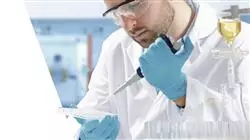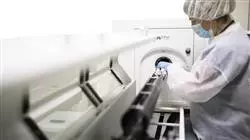University certificate
The world's largest faculty of physiotherapy”
Introduction to the Program
TECH has the best program on the educational market to update you on recognition and intervention techniques through biomedical images and you are only 1 click away from being able to access it”

The development of biomedical sciences and the application of Big Datastrategies for the analysis and processing of information have favored the evolution of imaging diagnosis. Today it is possible to obtain high resolution, clear and concise results, thanks to which professionals such as Physiotherapy can work in a more specific, safe and personalized way depending on the physical characteristics of the patient, as well as the specifications of your ailment: a contracture, a muscle tear, a bone displacement, an overload, etc.
Thanks to this, the effectiveness of the treatments increases, reducing recovery times and, therefore, guaranteeing a considerable and faster improvement in your quality of life. Based on this and the need on the part of these specialists to have a program that allows them to be up-to-date on developments in this field, TECH and its team of experts in Bioinformatics and Biomedical Engineering have developed this Postgraduate diploma It is a 450-hour educational experience through which the graduate will be able to delve into scientific advances in relation to recognition and intervention techniques through biomedical images. You will also be able to update your knowledge on the massive processing of clinical data through the most innovative Big Data techniques. To conclude, there will be a brief but intensive review of the applications of Artificial Intelligence and the Internet of Things (IoT) to Telemedicine.
All this throughout 6 months of the best and most exhaustive educational experience, in which a multitude of additional material has been included so that the graduate can delve into the different sections of the agenda in a personalized way: research articles, complementary readings, dynamic summaries, news, self-knowledge exercises and clinical cases. It is, therefore, a unique opportunity to update and renew your clinical practice through a 100% online degree that is perfectly compatible with your work activity.
A unique educational opportunity to delve into the advantages and disadvantages of image-guided interventionism through a 100% online educational experience”
This Postgraduate diploma in Biomedical Image Analysis and Big Data in E-Health contains the most complete and up-to-date scientific program on the market. The most important features include:
- The development of practical cases presented by experts in Biomedical Imaging and databases
- The graphic, schematic, and practical contents with which they are created, provide practical information on the disciplines that are essential for professional practice
- Practical exercises where the self-assessment process can be carried out to improve learning
- Its special emphasis on innovative methodologies
- Theoretical lessons, questions for the expert, debate forums on controversial topics, and individual reflection assignments
- Content that is accessible from any fixed or portable device with an Internet connection
The TECH team of experts has included hundreds of hours of diverse material in this program so that you can delve into the different sections of the agenda in a personalized way”
The program’s teaching staff includes professionals from the sector who contribute their work experience to this educational program, as well as renowned specialists from leading societies and prestigious universities.
Its multimedia content, developed with the latest educational technology, will provide the professional with situated and contextual learning, i.e., a simulated environment that will provide an immersive education designed to learn in real situations.
The design of this program focuses on Problem-Based Learning, by means of which the professional must try to solve different professional practice situations that are presented throughout the academic course. This will be done with the help of an innovative system of interactive videos made by renowned experts.
A perfect program to update you on the aspects to take into account in relation to radiation protection, both for you and for the patient"

You will be able to access the Virtual Campus from anywhere thanks to the compatibility of the platform with any device with an Internet connection, be it a tablet, PC or mobile"
Why study at TECH?
TECH is the world’s largest online university. With an impressive catalog of more than 14,000 university programs available in 11 languages, it is positioned as a leader in employability, with a 99% job placement rate. In addition, it relies on an enormous faculty of more than 6,000 professors of the highest international renown.

Study at the world's largest online university and guarantee your professional success. The future starts at TECH”
The world’s best online university according to FORBES
The prestigious Forbes magazine, specialized in business and finance, has highlighted TECH as “the world's best online university” This is what they have recently stated in an article in their digital edition in which they echo the success story of this institution, “thanks to the academic offer it provides, the selection of its teaching staff, and an innovative learning method aimed at educating the professionals of the future”
A revolutionary study method, a cutting-edge faculty and a practical focus: the key to TECH's success.
The most complete study plans on the university scene
TECH offers the most complete study plans on the university scene, with syllabuses that cover fundamental concepts and, at the same time, the main scientific advances in their specific scientific areas. In addition, these programs are continuously being updated to guarantee students the academic vanguard and the most in-demand professional skills. In this way, the university's qualifications provide its graduates with a significant advantage to propel their careers to success.
TECH offers the most comprehensive and intensive study plans on the current university scene.
A world-class teaching staff
TECH's teaching staff is made up of more than 6,000 professors with the highest international recognition. Professors, researchers and top executives of multinational companies, including Isaiah Covington, performance coach of the Boston Celtics; Magda Romanska, principal investigator at Harvard MetaLAB; Ignacio Wistumba, chairman of the department of translational molecular pathology at MD Anderson Cancer Center; and D.W. Pine, creative director of TIME magazine, among others.
Internationally renowned experts, specialized in different branches of Health, Technology, Communication and Business, form part of the TECH faculty.
A unique learning method
TECH is the first university to use Relearning in all its programs. It is the best online learning methodology, accredited with international teaching quality certifications, provided by prestigious educational agencies. In addition, this disruptive educational model is complemented with the “Case Method”, thereby setting up a unique online teaching strategy. Innovative teaching resources are also implemented, including detailed videos, infographics and interactive summaries.
TECH combines Relearning and the Case Method in all its university programs to guarantee excellent theoretical and practical learning, studying whenever and wherever you want.
The world's largest online university
TECH is the world’s largest online university. We are the largest educational institution, with the best and widest online educational catalog, one hundred percent online and covering the vast majority of areas of knowledge. We offer a large selection of our own degrees and accredited online undergraduate and postgraduate degrees. In total, more than 14,000 university degrees, in eleven different languages, make us the largest educational largest in the world.
TECH has the world's most extensive catalog of academic and official programs, available in more than 11 languages.
Google Premier Partner
The American technology giant has awarded TECH the Google Google Premier Partner badge. This award, which is only available to 3% of the world's companies, highlights the efficient, flexible and tailored experience that this university provides to students. The recognition as a Google Premier Partner not only accredits the maximum rigor, performance and investment in TECH's digital infrastructures, but also places this university as one of the world's leading technology companies.
Google has positioned TECH in the top 3% of the world's most important technology companies by awarding it its Google Premier Partner badge.
The official online university of the NBA
TECH is the official online university of the NBA. Thanks to our agreement with the biggest league in basketball, we offer our students exclusive university programs, as well as a wide variety of educational resources focused on the business of the league and other areas of the sports industry. Each program is made up of a uniquely designed syllabus and features exceptional guest hosts: professionals with a distinguished sports background who will offer their expertise on the most relevant topics.
TECH has been selected by the NBA, the world's top basketball league, as its official online university.
The top-rated university by its students
Students have positioned TECH as the world's top-rated university on the main review websites, with a highest rating of 4.9 out of 5, obtained from more than 1,000 reviews. These results consolidate TECH as the benchmark university institution at an international level, reflecting the excellence and positive impact of its educational model.” reflecting the excellence and positive impact of its educational model.”
TECH is the world’s top-rated university by its students.
Leaders in employability
TECH has managed to become the leading university in employability. 99% of its students obtain jobs in the academic field they have studied, within one year of completing any of the university's programs. A similar number achieve immediate career enhancement. All this thanks to a study methodology that bases its effectiveness on the acquisition of practical skills, which are absolutely necessary for professional development.
99% of TECH graduates find a job within a year of completing their studies.
Postgraduate Diploma in Biomedical Image Analysis and Big Data in E-Health.
Biomedical image analysis and Big Data in E-Health are two technologies that are used together to improve medical care and healthcare.
Biomedical image analysis refers to the processing and analysis of medical images, such as X-rays, CT scans, MRIs, ultrasounds, among others. The technology used in biomedical image analysis includes image processing algorithms, which make it possible to analyze and extract information from medical images for more accurate and detailed diagnosis.
On the other hand, Big Data in E-Health refers to the ability to collect large amounts of patient data and used for decision making and analysis. Big Data technology enables the collection and analysis of large amounts of data from a variety of sources, such as electronic medical records, patient sensor data, genomic databases, among others.
Applications of technologies in E-Health.
Early disease detection: Biomedical image analysis and Big Data can help in the early detection of diseases such as cancer by enabling the identification of patterns in large data sets.
Treatment selection: By analyzing data on previous treatments, clinicians can select the best available treatment for the patient.
Diagnosis customization: With the help of biomedical image analysis, a precise personalized diagnosis can be created for each patient, enabling more effective treatment.
Medical research: Big Data technology can be used in medical research to identify patterns and trends, which can lead to new discoveries and treatments.
Biomedical image analysis and Big Data are complementary technologies that can improve the healthcare process, enabling early disease detection, treatment selection, diagnostic personalization and advances in medical research.







